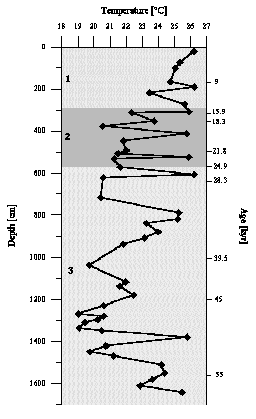
The Arabian Sea in the NW part of the Indian Ocean is characterized by strong seasonal variability of monsoonal upwelling and high primary productivity (Prell and Curry, 1981) that favour an exceptionally stable mid-water (200-1500 m) (Wyrtki, 1971) oxygen minimum zone (OMZ). Surface sediments from twenty-two locations on the Pakistan continental margin obtained during cruise SONNE 90 have been investigated by organic geochemical methods including organic carbon determination, gas chromatography, combined gas chromatography-mass spectrometry (GC/MS) and compound specific isotope analysis of extractable lipids to reconstruct the palaeoenvironment and to study the factors controlling the deposition, preservation and early diagenesis of organic matter. In addition, sea-surface temperatures (SST) have been determined to assess palaeoceanographic conditions.
The organic carbon contents of the surface samples vary between 0.6% and 3.9%. The variation of organic carbon
with water depth shows that significantly higher values are encountered within the OMZ and directly beneath. The values are considerably lower in the oxygenated region of the shelf
and continental slope (< 150 m and > 1500 m). This probably indicates that organic matter is enriched in sediments deposited under anoxic conditions.
All investigated sediment samples contain sterol compositions in the carbon number range from 26 to 30. Most of the detected components are derived from marine sources. This is consistent with the distribution patterns of other compound classes like n-fatty acids. Components of terrigenous and bacterial origin were found only in small amounts.
Sea-surface temperatures were determined from the alkenone unsaturation index (Uk37) of long-chain ketones in a piston core in the Indus Fan area. The calculated temperatures vary between 19°C and 26°C (Fig. 1) and indicate that oceanographic conditions changed significantly during the last 60.000 years. Temperatures of up to 26°C are representative of interglacial stages whereas temperatures down to 19°C occured at 30 and about 40-45 kyr B.P., the so-called "stage 3 event" (Hermelin and Shimmield, 1995).
Hermelin, J.O.R. & Shimmield, G. B., Paleoceanography 10, 85-116 (1995).
Prell, W.L. & Curry, W.B., Oceanol. Acta 4, 91-98 (1981).
Wyrtki, K., Oceanographic Atlas of the Int'l Indian Ocean Expedition, (Nat. Sci. Found., Washington D.C., 1971).
Fig. 1: Sea-surface temperature variation, based on long-chain alkenone unsaturation, in the Indus Fan during the last approximately 60 kyr. Numbers 1 to 3 indicate oxygen isotope stages.